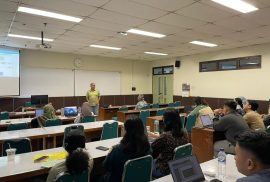
On Monday, October 18, 2021, the Introduction to Agricultural Technology course of TPHP UGM held a guest lecture with the theme “Indonesian Gastronomy”. This guest lecture was delivered by Prof. Dr. Ir. Murdijati Gardjito, M.S., who is a Professor of Food Science and Technology at UGM as well as an expert in Indonesian culinary and gastronomy. The guest lecture which took place at 09.00-10.40 WIB was conducted through the Zoom platform and hosted by Dr. Dwi Larasatie Nur Fibri, S.T.P., M.Sc., TPHP UGM lecturer.

Gastronomy is a collection of knowledge that includes a description of the origin and food, variety, biodiversity, and agrobiodiversity, and how humans enjoy food for their sustainability. Gastronomy encompasses humans and their environment. The environment acts as a provider of foodstuffs, while humans are a group, ethnicity, or race.
Gastronomy is the mother of food technology. The existence of on-farm and off-farm activities each produce other activities called primary processing (not changing the form) and secondary processing (changing the form). These activities are integrated into manufacturing technology to develop products that are ready for consumption. This is what will be studied in food technology.
Indonesian gastronomy has a history, local wisdom, legends, and myths, and blends with the kitchen arts that exist in each ethnic region. Indonesian kitchen art is the largest gastronomic kitchen in the world which includes 1041 ethnic kitchens throughout Indonesia. According to Murdijati et al’s Indonesian culinary research database, there are 3259 varieties of Indonesian food dishes. There are 199 variations in the number of spices in Indonesian food.
Spices from the East used by Europeans in the 15th century helped support Indonesian gastronomy in the development of world gastronomy. Nusantara spices have also shocked the world because their trade has created a new civilization for the world, not only for taste, but also for medicine, aroma therapy, preservation of corpses, and means of ritual activities. In addition, food also has functions and roles in the form of physiology, health, existence, communication, expression, and certain missions. For example, the colors on tumpeng have different meanings. The yellow color symbolizes commemorating something and the blue color symbolizes an apology.




